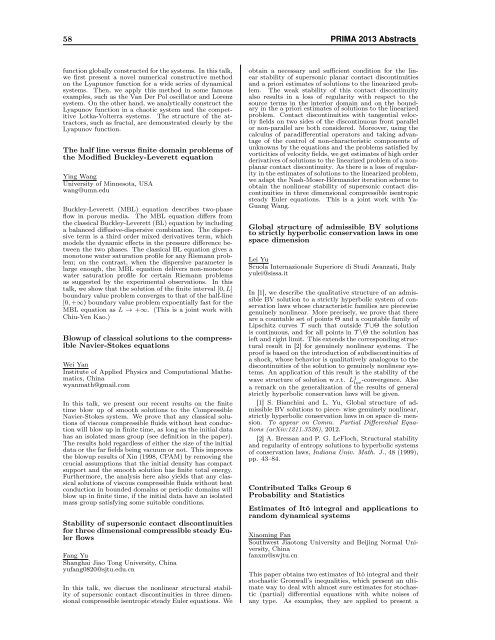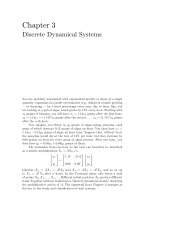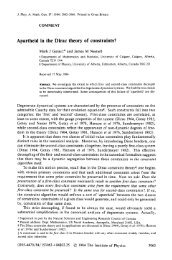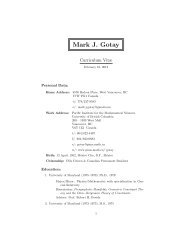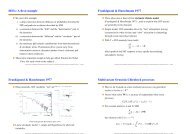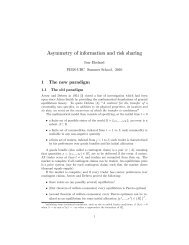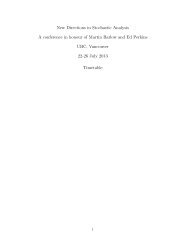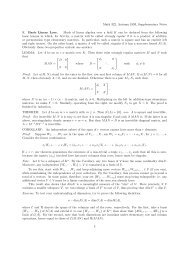57 PRIMA 2013 Abstractsand fountain theorem, we establish the existence of nontrivalsolutions for a class of quasilinear elliptic problemswith variable exponents. Also we show the existence ofpositivity of the infimum of all eigenvalues for the aboveproblem.Overdetermined boundary value problemswith strongly nonlinear elliptic PDEFengquan Li (with Boqiang Lv, Weilin Zou)Dalian University of Techology, Chinafqli@dlut.edu.cnWe consider the strongly nonlinear elliptic Dirichlet problemin a connected bounded domain, overdetermined withthe constant Neumann condition F (∇u) = c on theboundary. Here F is convex and positively homogeneousof degree 1, and its polar F ∗ represents the anisotropicnorm on R n . We prove th<strong>at</strong>, if this overdeterminedboundary value problem admits a solution in a suitableweak sense, then Ω must be of Wulff shape.Stability of boundary layers for the nonisentropiccompressible circularly symmetric2D flowCheng-Jie LiuShanghai Jiao Tong University, Chinacjliusjtu@gmail.comIn this paper, we study the asymptotic behavior of the circularlysymmetric solution to the initial boundary valueproblem of the compressible non-isentropic Navier-Stokesequ<strong>at</strong>ions in a two-dimensional exterior domain with impermeableboundary condition when the viscosities andthe he<strong>at</strong> conduction coefficient tend to zero. By multiscaleanalysis, we obtain th<strong>at</strong> away from the boundarythe compressible non-isentropic viscous flow can be approxim<strong>at</strong>edby the corresponding inviscid flow, and nearthe boundary there are boundary layers for the angularvelocity, density and temper<strong>at</strong>ure in the leading orderexpansions of solutions, while the radial velocity andpressure do not have boundary layers in the leading order.The boundary layers of velocity and temper<strong>at</strong>ure aredescribed by a nonlinear parabolic coupled system. Weprove the stability of boundary layers and rigorously justifythe asymptotic behavior of solutions in the L ∞ −normfor the small viscosities and he<strong>at</strong>-conduction limit in theLagrangian coordin<strong>at</strong>es, as long as the strength of theboundary layers is suitably small. Finally, we show th<strong>at</strong>the similar asymptotic behavior of the small viscositiesand he<strong>at</strong> conduction limit holds in the Eulerian coordin<strong>at</strong>esfor the compressible non-isentropic viscous flow.Dynamics in immune reactions during woundhealing processesJianzhong Su a) , Larrissa Owens a) and Akif Ibraguimov b)a) University of Texas <strong>at</strong> Arlington, USAb) Texas Tech Universitysu@uta.eduWe propose a partial differential equ<strong>at</strong>ion model adaptedfrom the principles of wound healing studies and analyzeit to gain insights regarding the dynamics of immunecells/proteins following the insertion of a foreign body.Specifically we look <strong>at</strong> the multiple roles of macrophagesand the conditions for stabilizing/destabilizing the equilibriumst<strong>at</strong>e. Furthermore, we investig<strong>at</strong>e the impact ofdiffusion and chemotaxis on the stability and the transientbehavior of the system.On the radi<strong>at</strong>ion field for wave equ<strong>at</strong>ionsFang WangPrinceton University, USAfangwang@m<strong>at</strong>h.princeton.eduDefinitions for the radi<strong>at</strong>ion field by Lax-Phillips andFriedlander are introduced for standard wave equ<strong>at</strong>ionon Minkowski space-time, which can be generalized tocurved space-time (such as Schiwarzschild space-time)and nonlinear wave equ<strong>at</strong>ions (such as Einstein vacuumequ<strong>at</strong>ions). Regularities of the radi<strong>at</strong>ion field are studied.Mapping property for Moller wave oper<strong>at</strong>or, whichmaps initial d<strong>at</strong>a to the radi<strong>at</strong>ion field, are investig<strong>at</strong>ed.In the case th<strong>at</strong> the Molloer wave oper<strong>at</strong>or is an (or alocal) isomorphism, the characteristic initial problem isconsidered.Rel<strong>at</strong>ionship between ω-limit Sets and MinimalSetsLarry WangSouthern Polytechnic St<strong>at</strong>e University, USAlwang@spsu.eduIn this paper, we study the rel<strong>at</strong>ion between ω-limit setsand minimal sets. It is known th<strong>at</strong> every minimal set is aω-limit set. However, not every ω-limit set is a minimalset, although it contains a minimal set. We would like toknow under wh<strong>at</strong> condition an ω-limit set turns out tobe a minimal set. We establish a necessary and sufficientcondition under which every ω-limit set is minimal.The regularity of semi-hyperbolic p<strong>at</strong>ches <strong>at</strong>sonic lines for the pressure gradient equ<strong>at</strong>ionin gas dynamicsQin WangShanghai Jiao Tong University, Chinam<strong>at</strong>hwq@sjtu.edu.cnWe study the uniform regularity of semi-hyperbolicp<strong>at</strong>ches of self-similar solutions near sonic lines to a generalRiemann problem for the pressure gradient equ<strong>at</strong>ion.This type of solutions, in which one family of characteristicsstarts on a sonic line and ends on a transonicshock wave, is common for the Riemann problems for theEuler system in two space dimensions. The global existenceof smooth solutions was established in Song andZheng(2009), but the smoothness near the sonic lines isnot clear. We establish th<strong>at</strong> the smooth solutions are uniformlysmooth up to their sonic boundaries and the soniclines are C 1 continuous.Constructing global Lyapunov function forcomplex systemsXinAn WangShanghai Jiao Tong University, Chinawangxinan@sjtu.edu.cnLyapunov function, as one of the most significant conceptsin dynamical systems, has been widely applied inmany disciplines. However, the classical Lyapunov functionin the theory of ordinary differential equ<strong>at</strong>ions areusually restricted to the analysis of the stability near theequilibriums of the system, and no general constructivemethod has been found. Thus, it cannot be applied tomore complex dynamical behaviors, such as multi-stablest<strong>at</strong>es, periodic <strong>at</strong>tractor like limit cycle, and chaos. Recently,a series of works based on the construction of potentialfunction in physics for stochastic dynamical processdemonstr<strong>at</strong>e potential function plays a critical rolein the quantit<strong>at</strong>ive analysis of dynamical systems. In deterministiccases, the potential function is the Lyapunov
58 PRIMA 2013 Abstractsfunction globally constructed for the systems. In this talk,we first present a novel numerical constructive methodon the Lyapunov function for a wide series of dynamicalsystems. Then, we apply this method in some famousexamples, such as the Van Der Pol oscill<strong>at</strong>or and Lorenzsystem. On the other hand, we analytically construct theLyapunov function in a chaotic system and the competitiveLotka-Volterra systems. The structure of the <strong>at</strong>tractors,such as fractal, are demonstr<strong>at</strong>ed clearly by theLyapunov function.The half line versus finite domain problems ofthe Modified Buckley-Leverett equ<strong>at</strong>ionYing WangUniversity of Minnesota, USAwang@umn.eduBuckley-Leverett (MBL) equ<strong>at</strong>ion describes two-phaseflow in porous media. The MBL equ<strong>at</strong>ion differs fromthe classical Buckley-Leverett (BL) equ<strong>at</strong>ion by includinga balanced diffusive-dispersive combin<strong>at</strong>ion. The dispersiveterm is a third order mixed deriv<strong>at</strong>ives term, whichmodels the dynamic effects in the pressure difference betweenthe two phases. The classical BL equ<strong>at</strong>ion gives amonotone w<strong>at</strong>er s<strong>at</strong>ur<strong>at</strong>ion profile for any Riemann problem;on the contrast, when the dispersive parameter islarge enough, the MBL equ<strong>at</strong>ion delivers non-monotonew<strong>at</strong>er s<strong>at</strong>ur<strong>at</strong>ion profile for certain Riemann problemsas suggested by the experimental observ<strong>at</strong>ions. In thistalk, we show th<strong>at</strong> the solution of the finite interval [0, L]boundary value problem converges to th<strong>at</strong> of the half-line[0, +∞) boundary value problem expoentially fast for theMBL equ<strong>at</strong>ion as L → +∞. (This is a joint work withChiu-Yen Kao.)Blowup of classical solutions to the compressibleNavier-Stokes equ<strong>at</strong>ionsWei YanInstitute of Applied Physics and Comput<strong>at</strong>ional M<strong>at</strong>hem<strong>at</strong>ics,Chinawyanm<strong>at</strong>h@gmail.comIn this talk, we present our recent results on the finitetime blow up of smooth solutions to the CompressibleNavier-Stokes system. We prove th<strong>at</strong> any classical solutionsof viscous compressible fluids without he<strong>at</strong> conductionwill blow up in finite time, as long as the initial d<strong>at</strong>ahas an isol<strong>at</strong>ed mass group (see definition in the paper).The results hold regardless of either the size of the initiald<strong>at</strong>a or the far fields being vacuum or not. This improvesthe blowup results of Xin (1998, CPAM) by removing thecrucial assumptions th<strong>at</strong> the initial density has compactsupport and the smooth solution has finite total energy.Furthermore, the analysis here also yields th<strong>at</strong> any classicalsolutions of viscous compressible fluids without he<strong>at</strong>conduction in bounded domains or periodic domains willblow up in finite time, if the initial d<strong>at</strong>a have an isol<strong>at</strong>edmass group s<strong>at</strong>isfying some suitable conditions.Stability of supersonic contact discontinuitiesfor three dimensional compressible steady EulerflowsFang YuShanghai Jiao Tong University, Chinayufang0820@sjtu.edu.cnIn this talk, we discuss the nonlinear structural stabilityof supersonic contact discontinuities in three dimensionalcompressible isentropic steady Euler equ<strong>at</strong>ions. Weobtain a necessary and sufficient condition for the linearstability of supersonic planar contact discontinuitiesand a priori estim<strong>at</strong>es of solutions to the linearized problem.The weak stability of this contact discontinuityalso results in a loss of regularity with respect to thesource terms in the interior domain and on the boundaryin the a priori estim<strong>at</strong>es of solutions to the linearizedproblem. Contact discontinuities with tangential velocityfields on two sides of the discontinuous front parallelor non-parallel are both considered. Moreover, using thecalculus of paradifferential oper<strong>at</strong>ors and taking advantageof the control of non-characteristic components ofunknowns by the equ<strong>at</strong>ions and the problems s<strong>at</strong>isfied byvorticities of velocity fields, we get estim<strong>at</strong>es of high orderderiv<strong>at</strong>ives of solutions to the linearized problem of a nonplanarcontact discontinuity. As there is a loss of regularityin the estim<strong>at</strong>es of solutions to the linearized problem,we adapt the Nash-Moser-Hörmander iter<strong>at</strong>ion scheme toobtain the nonlinear stability of supersonic contact discontinuitiesin three dimensional compressible isentropicsteady Euler equ<strong>at</strong>ions. This is a joint work with Ya-Guang Wang.Global structure of admissible BV solutionsto strictly hyperbolic conserv<strong>at</strong>ion laws in onespace dimensionLei YuScuola Internazionale Superiore di Studi Avanz<strong>at</strong>i, Italyyulei@sissa.itIn [1], we describe the qualit<strong>at</strong>ive structure of an admissibleBV solution to a strictly hyperbolic system of conserv<strong>at</strong>ionlaws whose characteristic families are piecewisegenuinely nonlinear. More precisely, we prove th<strong>at</strong> thereare a countable set of points Θ and a countable family ofLipschitz curves T such th<strong>at</strong> outside T ∪Θ the solutionis continuous, and for all points in T \Θ the solution hasleft and right limit. This extends the corresponding structuralresult in [2] for genuinely nonlinear systems. Theproof is based on the introduction of subdiscontinuities ofa shock, whose behavior is qualit<strong>at</strong>ively analogous to thediscontinuities of the solution to genuinely nonlinear systems.An applic<strong>at</strong>ion of this result is the stability of thewave structure of solution w.r.t. L 1 loc-convergence. Alsoa remark on the generaliz<strong>at</strong>ion of the results of generalstrictly hyperbolic conserv<strong>at</strong>ion laws will be given.[1] S. Bianchini and L. Yu, Global structure of admissibleBV solutions to piece- wise genuinely nonlinear,strictly hyperbolic conserv<strong>at</strong>ion laws in on space di- mension.To appear on Comm. Partial Differential Equ<strong>at</strong>ions(arXiv:1211.3526), 2012.[2] A. Bressan and P. G. LeFloch, Structural stabilityand regularity of entropy solutions to hyperbolic systemsof conserv<strong>at</strong>ion laws, Indiana Univ. M<strong>at</strong>h. J., 48 (1999),pp. 43–84.Contributed Talks Group 6Probability and St<strong>at</strong>isticsEstim<strong>at</strong>es of Itô integral and applic<strong>at</strong>ions torandom dynamical systemsXiaoming FanSouthwest Jiaotong University and Beijing Normal University,Chinafanxm@swjtu.cnThis paper obtains two estim<strong>at</strong>es of Itô integral and theirstochastic Gronwall’s inequalities, which present an ultim<strong>at</strong>eway to deal with almost sure estim<strong>at</strong>es for stochastic(partial) differential equ<strong>at</strong>ions with white noises ofany type. As examples, they are applied to present a
- Page 2 and 3:
1PRIMA 2013-Table of ContentsTable
- Page 4 and 5:
3PRIMA 2013-OrganizationOrganizatio
- Page 6 and 7:
5PRIMA 2013-OrganizationYoshikazu G
- Page 8 and 9:
7PRIMA 2013-Useful InformationUsefu
- Page 10 and 11:
9PRIMA 2013-Useful InformationTaxi:
- Page 12 and 13:
11PRIMA 2013-Useful Informationmath
- Page 14 and 15:
13PRIMA 2013 Program-Schedule-at-a-
- Page 16 and 17:
15PRIMA 2013 Program-Monday, June 2
- Page 18 and 19:
17PRIMA 2013 Program-Monday, June 2
- Page 20 and 21:
19PRIMA 2013 Program-Monday, June 2
- Page 22 and 23:
21PRIMA 2013 Program-Monday, June 2
- Page 24 and 25:
23PRIMA 2013 Program-Tuesday, June
- Page 26 and 27:
25PRIMA 2013 Program-Tuesday, June
- Page 29 and 30:
28PRIMA 2013 Program-Tuesday, June
- Page 31 and 32:
30PRIMA 2013 Program-Tuesday, June
- Page 33 and 34:
32PRIMA 2013 Program-Wednesday, Jun
- Page 35 and 36:
34PRIMA 2013 Program- Thursday, Jun
- Page 37 and 38:
36PRIMA 2013 Program- Thursday, Jun
- Page 39 and 40:
38PRIMA 2013 Program- Thursday, Jun
- Page 41 and 42:
40PRIMA 2013 Program- Thursday, Jun
- Page 43 and 44:
42PRIMA 2013 Program- Friday, June
- Page 45 and 46:
44PRIMA 2013 Program- Friday, June
- Page 48 and 49:
1 PRIMA 2013 AbstractsContents1 Pub
- Page 50 and 51:
3 PRIMA 2013 Abstractsof subfactors
- Page 52 and 53:
5 PRIMA 2013 AbstractsprocessesXu S
- Page 54 and 55: 7 PRIMA 2013 AbstractsIn this talk
- Page 56 and 57: 9 PRIMA 2013 Abstractsindependently
- Page 58 and 59: 11 PRIMA 2013 AbstractsEnumerating,
- Page 60 and 61: 13 PRIMA 2013 AbstractsRyuhei Uehar
- Page 62 and 63: 15 PRIMA 2013 AbstractsIn this talk
- Page 64 and 65: 17 PRIMA 2013 AbstractsSpecial Sess
- Page 66 and 67: 19 PRIMA 2013 Abstractscritical slo
- Page 68 and 69: 21 PRIMA 2013 AbstractsSpecial Sess
- Page 70 and 71: 23 PRIMA 2013 Abstractsstrictly awa
- Page 72 and 73: 25 PRIMA 2013 AbstractsPedram Hekma
- Page 74 and 75: 27 PRIMA 2013 Abstractsis well-know
- Page 76 and 77: 29 PRIMA 2013 Abstractssolid substr
- Page 78 and 79: 31 PRIMA 2013 AbstractsRapoport-Zin
- Page 80 and 81: 33 PRIMA 2013 Abstractssense. Our a
- Page 82 and 83: 35 PRIMA 2013 AbstractsIn an econom
- Page 84 and 85: 37 PRIMA 2013 AbstractsKyoto Univer
- Page 86 and 87: 39 PRIMA 2013 AbstractsAlexander Mo
- Page 88 and 89: 41 PRIMA 2013 AbstractsOsamu SaekiK
- Page 90 and 91: 43 PRIMA 2013 Abstractsopen Delzant
- Page 92 and 93: 45 PRIMA 2013 AbstractsJian ZhouTsi
- Page 94 and 95: 47 PRIMA 2013 AbstractsJiaqun WeiNa
- Page 96 and 97: 49 PRIMA 2013 Abstractsthe end of 2
- Page 98 and 99: 51 PRIMA 2013 AbstractsJongyook Par
- Page 100 and 101: 53 PRIMA 2013 AbstractsPancyclicity
- Page 102 and 103: 55 PRIMA 2013 AbstractsEfficient nu
- Page 106: 59 PRIMA 2013 Abstractsformula esti


